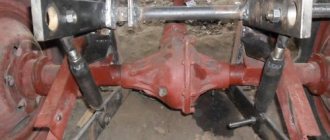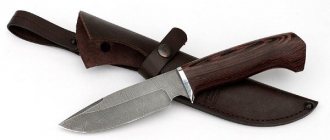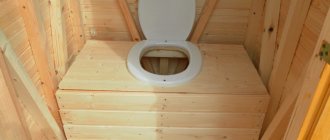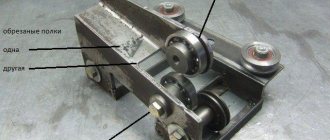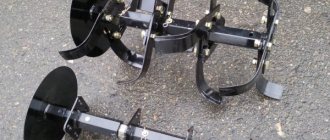Today we will dive into the unique art of making knife handles with our own hands: kitchen, hunting, fishing, folding and samurai swords.
This article describes in detail all the steps on how to make a knife handle, by following which you can create your own unique knife.
Necessary premises:
- Lumber store.
- Metal shop.
- Paint booth for drying epoxy resin.
Necessary tools and mechanisms:
- Band saw for wood.
- Saw for metal.
- Grinding machine.
- Marker.
- Files.
- Drilling machine.
- Clamps.
Necessary materials:
- Blade of knife.
- Material (wood, plastic, compressed corn cob, mammoth ivory, stone, etc.).
- Epoxy resin.
- Insulating tape.
- Sandpaper grit 200-600.
Additional materials:
- Metal pins.
- Colored inserts (small inserts between the wooden and metal parts of the knife handle).
Making a handle with your own hands step by step
The simplicity of the design of the knife and its handle makes it easy to make this tool with your own hands.
For example, if you have a high-quality blade with a damaged handle, you can easily update it by making a handle from scrap materials according to the algorithm given in our article.
Required Tools
As a rule, most craftsmen make knife handles from wood, although other natural and synthetic materials are also suitable for this purpose.
Based on the selected material, the tools for the job are selected. For example, for wood processing you will definitely need special impregnations (for example, linseed oil), which will protect the finished product from moisture and other negative environmental factors.
To process the material you will also need special tools. The easiest way to process wood is with a cutter, chisel or rasp, but to work with metal you will need a special vice and abrasive stones. Power tools can also be useful for processing materials of increased strength: drills, jigsaws, chisels, etc.
Requirements for size and shape
There are no clear requirements for the size of hunting knives: everyone is guided by considerations of personal convenience and the functions that the blade will perform (Figure 4).
The optimal blade length for a hunting knife is 10 cm. With the help of such a tool, you can cut up game and use it for planing wood or other purposes.
Figure 4. Variety of sizes and shapes
The minimum length of the handle of a quality knife is 11-13 cm, while the width of the finished product is determined individually, depending on the personal preferences of the future owner. As for the shape of the blade, an oval or convex handle is considered optimal for a hunting knife, which ensures the convenience and efficiency of using the tool.
Types of materials used
The types of materials for making knife handles are very diverse. For this purpose, both natural materials, such as wood or leather, and synthetic materials, such as metal, plastic or rubber, are used.
The final choice of material depends on your skills, capabilities and personal preferences. To make it easier for you to make your choice, we will provide more detailed information about each type of material that can be used to make the handle of a hunting knife.
Tree
Wood is considered one of the most popular materials for making a hunting knife handle. Typically, hardwoods such as walnut, ash, birch, beech, cherry, hornbeam, oak or maple are used for this purpose (Figure 5).
If you want to make a wooden knife handle with your own hands that is not only durable, but also original, you can use exotic types of wood. Breeds such as merbau, amaranth, bubingo or zebrano do not grow in our latitudes, but have sufficient strength and attractive appearance, and are ideal for making knife handles.
Figure 5. Options made of wood
If you don't have a suitable piece of natural wood, you can always use parquet pieces. This flooring is made from durable wood that is ideal for making hunting knife handles.
Of course, in some respects natural wood is inferior to synthetic materials in terms of wear resistance and durability, but it also has certain advantages. For example, this natural material is easy to process, it has a unique texture, and also provides reliable grip on the palm and allows you to work outdoors for a long time, even in severe frost.
Birch bark
A handle for a hunting knife can also be made from birch bark. This material is one of the simplest and most affordable, and working with it requires a minimal set of tools. The obvious advantage of birch bark handles is that they contain natural birch tar, which protects the finished product from moisture and rotting. In addition, birch bark has low thermal conductivity, so working with a knife with such a handle will be comfortable in both heat and cold (Figure 6).
Figure 6. The procedure for making a product from type-laid birch bark
To make a birch bark handle, the top layer of birch bark is used, which is cut into small pieces, glued with epoxy resin and compressed into a briquette using a vice. Thanks to such a simple design, the handle can be made in just one day. The only drawback of such a handle is that birch bark absorbs odor very well, so if you use a knife to cut game or fish, the handle will absorb these odors and it will be extremely difficult to get rid of them in the future.
Leather
Genuine leather is also a suitable material for making the handles of Finnish and other knives. As a rule, the same typesetting technology is used to produce the workpiece as for the manufacture of birch bark handles (Figure 7).
Figure 7. Leather products are comfortable and durable
Along with the obvious advantages of natural material - wear resistance, low thermal conductivity and comfort, and leather handles, there are also certain disadvantages. As with birch bark, genuine leather absorbs odors very well, so it is usually used for making tourist or camping knives that are not used for processing game or fish. In addition, if you use and store such a knife incorrectly, the leather may begin to rot and the handle will have to be replaced. Therefore, experts recommend that after each use, thoroughly rinse and dry the knife, followed by treating the handle with special protective agents for the skin or natural wax.
Plastic
Modern composites are much superior to natural materials in their performance characteristics. High-quality plastic does not absorb moisture and odors, has low thermal conductivity and fits comfortably in the hand, allowing you to wield the knife for a long time without fatigue.
Handle decor
A homemade knife handle can be made unique - any material suitable for such use can be decorated. In this case, you can show your imagination and accuracy - real handmade work. An engraving sketch or photo is prepared in advance, calculating the size of the handle. You can apply such a pattern to all materials except typesetting, but each has its own technique:
- Burning a design is suitable for wood, plastics, rubber and composites.
- Engraving is more versatile, but such a design requires a tool and a fair amount of perseverance.
- Etching is only suitable for metal handles, but other parts need to be protected.
- On soft materials, different patterns can be cut with a carpenter's knife, but such work is difficult.
If there are no such opportunities or desires, then we make the drawing with paint. You can decorate the handle using a paracord braid or leather cord. Simple options do not look unique and are quite common, but there are patterns with interesting patterns that need to be woven according to the instructions. Examples of braids that will add grace to the handle:
- snake knot;
- Turkish head;
- ear;
- cobra.
By combining several individual options and colors of cord, you can get a new beautiful type of weaving. Paracords for braiding come in two or three colors from the very beginning, which will give the pattern greater depth - you just need to show your imagination and work with your hands for an interesting result. A braided handle will slip less, and the cord can absorb sweat and other foreign liquids. Some craftsmen weave an interesting pattern directly onto the shank of the blade and fill it with epoxy resin or make artificial amber as a base for the handle.
Making a knife handle with your own hands is not difficult from start to finish. The simplest way is to braid the shank of the blade with a cord or carve it out of a wooden block. But the choice of material depends on general aesthetic views and the required strength. Depending on the manufacturing and fastening method, the handle must be fixed with adhesive compounds. After the work is done, the finished handle is decorated with ornaments, covered with leather or braided with cord.

